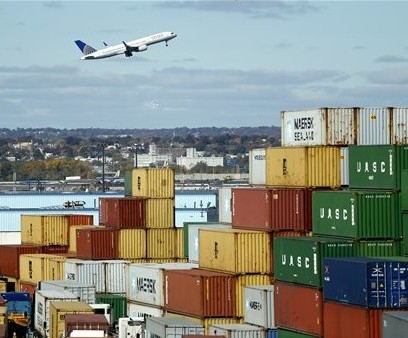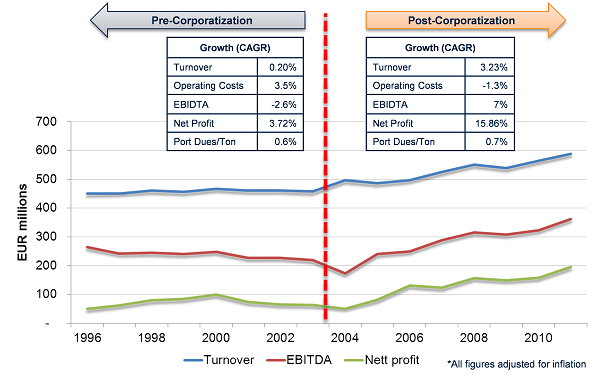“An effective management model to bring down costs can be gleaned from the airport industry”. That is the central argument of a viewpoint article by Peter de Langen and Periklis Saragiotis – published at the blogs page of Brookings Insitute, and PortEconomics.eu.
The viewpoint:
Why ports should be managed like airports
Sea transport is the cheapest form of transport and more than 75 percent of international merchandise is carried by vessels. Yet, costs are still substantially higher than they should be. This is especially evident in Africa and the Pacific where countries pay on average 40 percent to 70 percent more than developed countries for the international transport of their imports. High costs deeply hurt consumers and producers alike and reduce a country’s competitiveness. But an effective management model to bring down costs can be gleaned from the airport industry.
Effective port governance deeply influences freight transport costs as it can lead to better maritime and hinterland connectivity, smooth trade processes, and attractive port costs. One way to reduce costs and inefficiencies at ports is to introduce private-sector participation. Private port operations typically lead to a more efficient and competitively priced port services, provided that the appropriate regulatory regime is in place. Most of the terminals are currently operated by private companies; most major port reform challenges now concern the role and institutional position of the “port authority.”
When the port authority is a branch of the public administration, as is the case in most countries, political considerations often override commercial criteria. This often leads to insufficient or unreasonably high levels of investments, as well as investments in the wrong place (often to attract employment to less developed regions) or with wrong characteristics (e.g., depth and size), resulting in an underutilization of existing port assets and erroneous port pricing decisions.
The emerging best practice model is corporatization, in which the government owns the landlord port development company but gives it full autonomy to make decisions based on commercial considerations. Corporatization of the port authority changes the organizational culture towards value-creation and investment generation for the entire port complex. For examples, the port of Rotterdam substantially improved its performance after the reform. Operating costs were reduced, while capital investments, market share and overall profits increased (see Figure 1).
Figure 1: Performance effects of the corporatization of Port of Rotterdam Authority
Corporatization does not necessarily mean privatization. Most countries are reluctant to privatize their port authorities given the strategic relevance of the ports for the economy and the public interests involved. Corporatization can result in a government-owned port development company, with a broad mandate to develop the port complex and attract new customers, both port users and tenants (e.g., terminal operators, logistics service providers, and manufacturers).
Port reform can get some inspiration from the airport industry. In many countries, airports migrated from a purely government administration to an airport corporation, thus unlocking its tremendous profit potential and generating cash from new revenue streams. According to a recent survey of the Airports Council International-North America, most airports in the U.S. and Canada produce almost as much revenues from non-aeronautical activities (parking, retail, food, hotel, and conference facilities) as from fees from passengers and airlines.
Port reforms in most countries in Europe (i.e., Netherlands, Germany, Belgium, Portugal, and France) as well as in the rest of the world (Taiwan, Canada, Indonesia, Morocco, and Oman) slowly move towards a state-owned corporatized entity. There are four main lessons to consider when embarking on port reform:
- There should be clearly defined commercial targets. These goals include growth of throughput volumes, attraction of investments of world class players to the port, increasing maritime and intermodal connectivity, and reduced cost and congestion levels. Generally, return on investment is best treated as necessary for long-run financial sustainability. Once the direction is clear, choices on how to achieve these objectives can be fully based on commercial logic.
- There needs to be an explicit aim to be financially self-sufficient. The port development company can get loans to finance investments and recover investments through port dues to shipping lines, lease fees from tenants, and perhaps other revenue streams. It may benefit from government investments in transport infrastructure (e.g., road, rail, and inland waterways) just as other users benefit from such investments.
- The port development company should be fully autonomous, with an independent and qualified supervisory board. The engagement of industry expertise into the management of such a port development company is essential. Running a corporatized port authority requires deep knowledge of the port and maritime business; an understanding of user requirements (i.e., tenants, shipping lines, and logistics service providers) in terms of infrastructure, utilities, information platforms and labor; and entrepreneurial capabilities to capture newly emerging opportunities—for instance, in offshore, clean energy, and bio-based industries.
- It should be regulated either by a competition authority or by a port regulator in order to secure public interests, including preventing abuse of market power.In the best case model, government entities (regional, national, and supranational) have all regulatory responsibilities. Hence, the name port authority is best changed to “port development company.”
The potential benefits of turning public port authorities into truly corporatized port development companies are substantial for the port users and the society at large. Lessons learned from the airport sector’s corporatization process lead us to believe that this maybe the future of the port sector as well.
(First published in brookings.edu)













